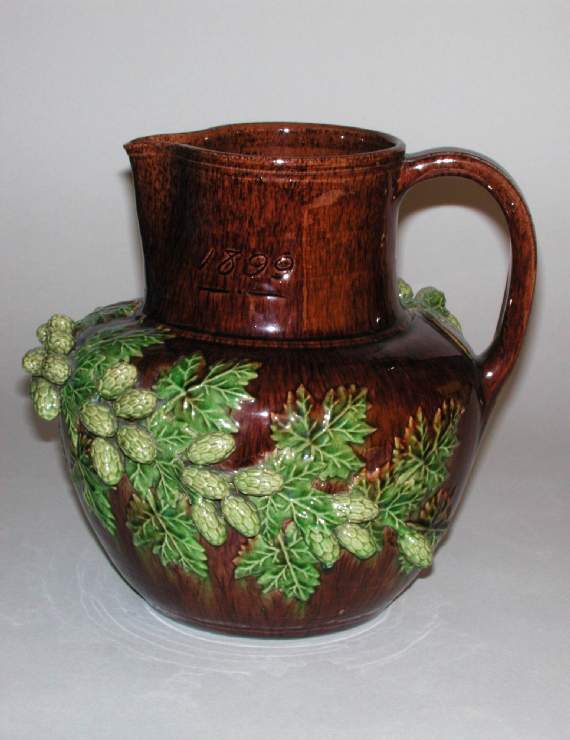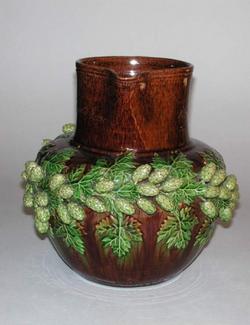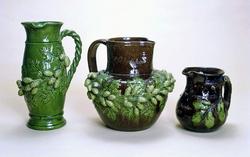Current Location: In storage
Maker(s)
Production:
Rye Pottery
Entities
Categories
Description
Earthenware 'hop jug', with moulded and applied decoration under green and brown flecked lead (?) glazes.
Earthenware with moulded and applied decoration under green and brown flecked lead (?) glazes. Squat ovoid body with pronounced shoulder, cylindrical neck, pinched at the front to form a lip, and strap handle. A wreath of hops and leaves runs round the body on and just below the shoulder. The neck is incised on one side 'J.W.L. Glaisher' and on the other '1899', The body is brown; the hops, green.
Notes
History note: Made to commission at the Rye Pottery and purchased there for £1.5s.0d. on 12 December 1899 by Dr J.W.L. Glaisher, FRS, Trinity College Cambridge
Legal notes
Dr J.W.L. Glaisher Bequest
Measurements and weight
Height: 22.5 cm
Acquisition and important dates
Method of acquisition: Bequeathed
(1928-12-07)
by
Glaisher, J. W. L., Dr
Dating
19th Century, Late
Victorian
Production date:
AD 1899
Note
The Belle Vue Pottery at Rye was one of several English country potteries which made 'Art Pottery' as well as traditional useful wares. It was founded in 1868 by Frederick Mitchell (1819-75) whose nephew, Frederick Thomas Mitchell (1864-1920) made this jug for Dr J.W.L. Glaisher, a fellow of Trinity College, Cambridge. In the 1870s the pottery became famous for pig-shaped flasks known as 'Sussex pigs', and for 'hop wares' which were decorated with moulded and applied wreaths of hops and glazed green and brown. Unlike many green glazes which were coloured with copper oxide, this was coloured with brass dust produced in the manufacture of pins. When F.T. Mitchell took over the pottery in 1896 on the death of his uncle's widow, he revived these wares and continued to make them in the twentieth century. When Glaisher bought this jug in 1899, Mitchell told him that the idea for the hop decoration came from the hops which twined round the door of the old Cadborough pottery at Rye, which his uncle had left in 1868. The decoration was particularly suitable for beer jugs, but was also used on other forms. A small puzzle jug decorated with a spray of oak leaves and acorns was purchased by Glaisher on another visit in 1912 (C.83C-1928).
School or Style
Art Pottery
Components of the work
Body
Decoration
Materials used in production
Lead-glaze
Earthenware
Techniques used in production
Lead-glazing
Inscription or legends present
- Text: Rye/Pottery/F. Mitchell/1899 /Sussex
- Location: On base
- Method of creation: Incised
- Type: Mark
- Text: J.W.L. Glaisher
- Location: On the neck
- Method of creation: Incised
- Type: Inscription
- Text: 1899
- Location: On the neck
- Method of creation: Incised
- Type: Date
References and bibliographic entries
Identification numbers
Accession number: C.38B-1928
Primary reference Number: 74756
Old object number: 1057
Stable URI
Audit data
Created: Saturday 6 August 2011
Updated: Tuesday 30 April 2024
Last processed: Tuesday 13 May 2025
Associated departments & institutions
Owner or interested party:
The Fitzwilliam Museum
Associated department:
Applied Arts








